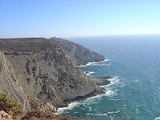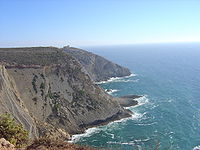
Cabo Espichel
Encyclopedia

Sesimbra
-References:Bibliography*The Rough Guide to Portugal; 11th edition, March 2005; ISBN 1-84353-438-X*Rentes de Carvalho, J. - Portugal, um guia para amigos ; De Arbeiderspers, 9th ed. August 1999; ISBN 90-295-3457-5Notes...
, Portugal
Portugal
Portugal , officially the Portuguese Republic is a country situated in southwestern Europe on the Iberian Peninsula. Portugal is the westernmost country of Europe, and is bordered by the Atlantic Ocean to the West and South and by Spain to the North and East. The Atlantic archipelagos of the...
. Tourists are drawn there due to breathtaking views of its cliffs facing the Atlantic Ocean
Atlantic Ocean
The Atlantic Ocean is the second-largest of the world's oceanic divisions. With a total area of about , it covers approximately 20% of the Earth's surface and about 26% of its water surface area...
.
The location is famous for the a sanctuary complex (lit. Santuário de Nossa Senhora do Cabo Espichel), built extremely close to the edge of the tall cliffs, which includes a church still in use today.
Also famous, are the several dinosaur
Dinosaur
Dinosaurs are a diverse group of animals of the clade and superorder Dinosauria. They were the dominant terrestrial vertebrates for over 160 million years, from the late Triassic period until the end of the Cretaceous , when the Cretaceous–Paleogene extinction event led to the extinction of...
fossil trackway
Trackway
A trackway is an ancient route of travel for people or animals. In biology, a trackway can be a set of impressions in the soft earth, usually a set of footprints, left by an animal. A fossil trackway is the fossilized imprint of a trackway. Trackways have been found all over the world...
s exposed in some of the now tilted Jurassic
Jurassic
The Jurassic is a geologic period and system that extends from about Mya to Mya, that is, from the end of the Triassic to the beginning of the Cretaceous. The Jurassic constitutes the middle period of the Mesozoic era, also known as the age of reptiles. The start of the period is marked by...
strata
Stratum
In geology and related fields, a stratum is a layer of sedimentary rock or soil with internally consistent characteristics that distinguish it from other layers...
which form the cape's cliffs. It is said that local superstition interpreted the trackway
Fossil trackway
A fossil trackway is a type of trace fossil, a trackway made by an organism. Many fossil trackways were made by dinosaurs, early tetrapods, and other quadrupeds and bipeds on land...
s as the path taken by the Holy Virgin ("Nossa Senhora") when riding a giant mule from the ocean and up the cliffs, which led to the eventual construction of the convent at that location.

